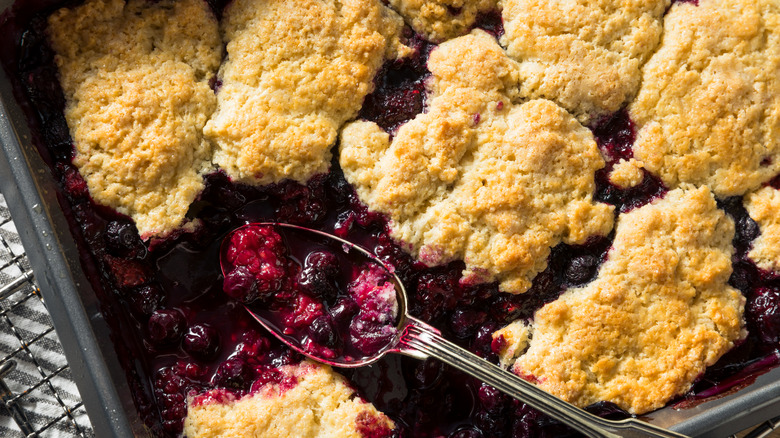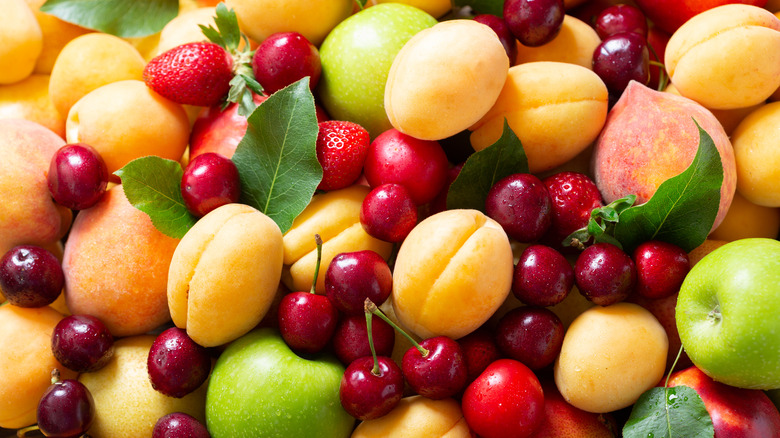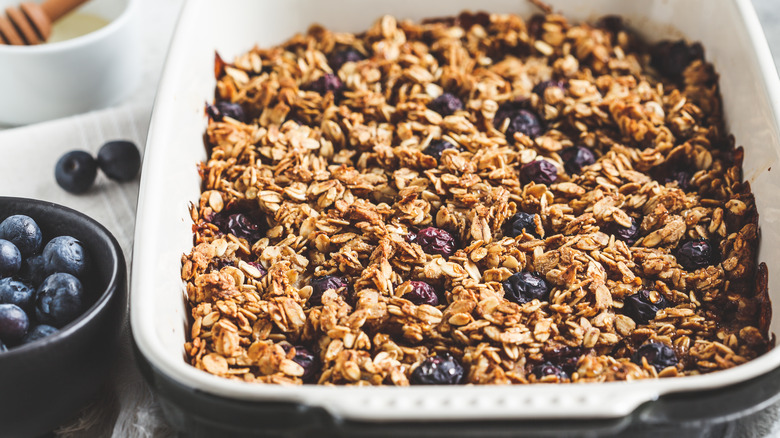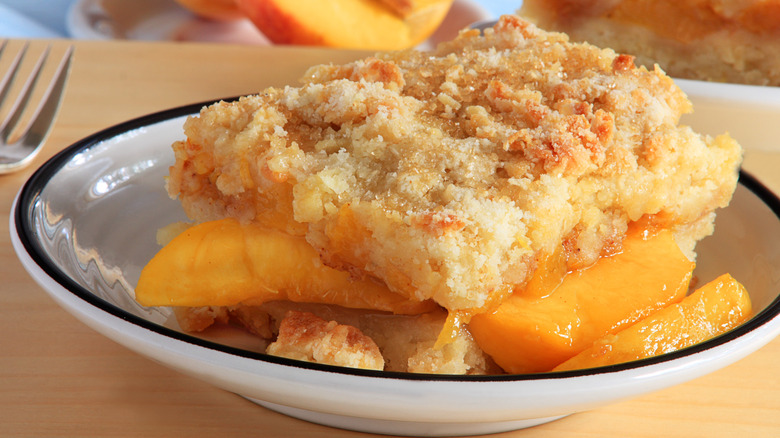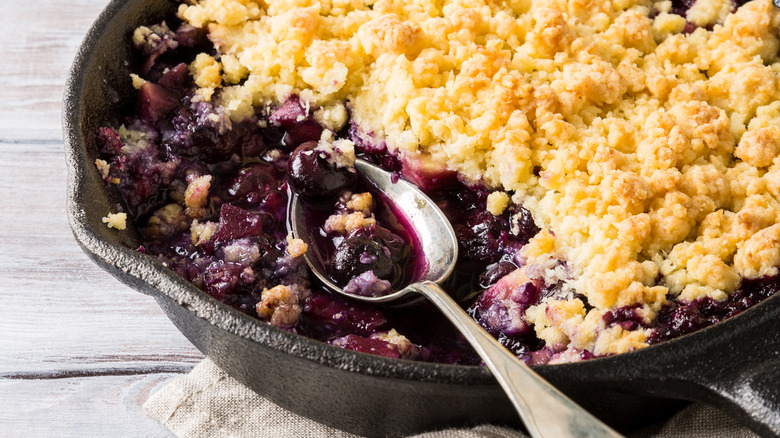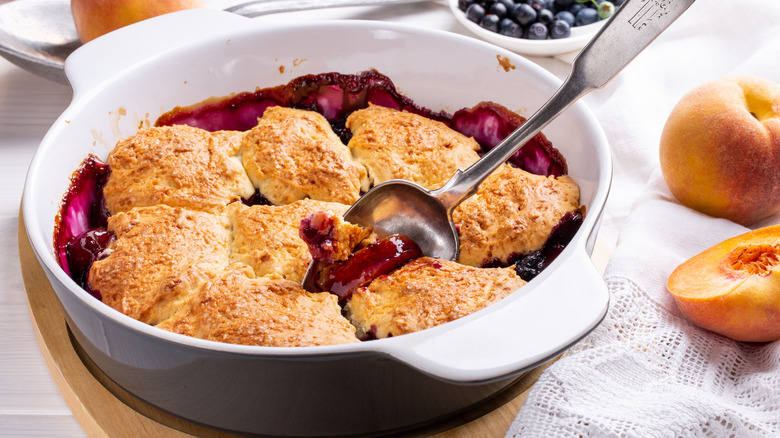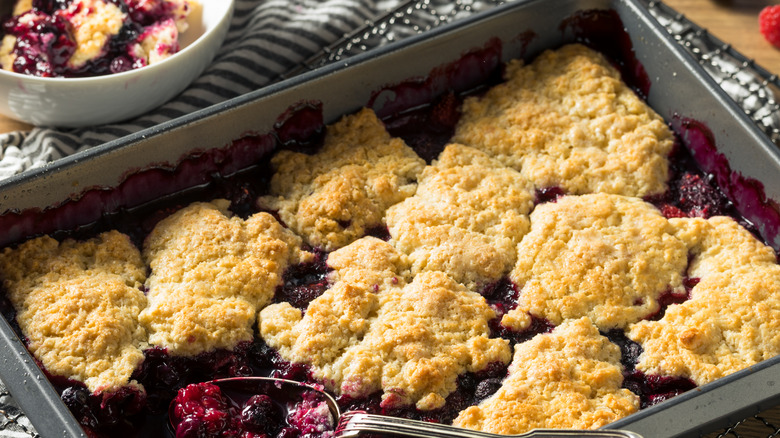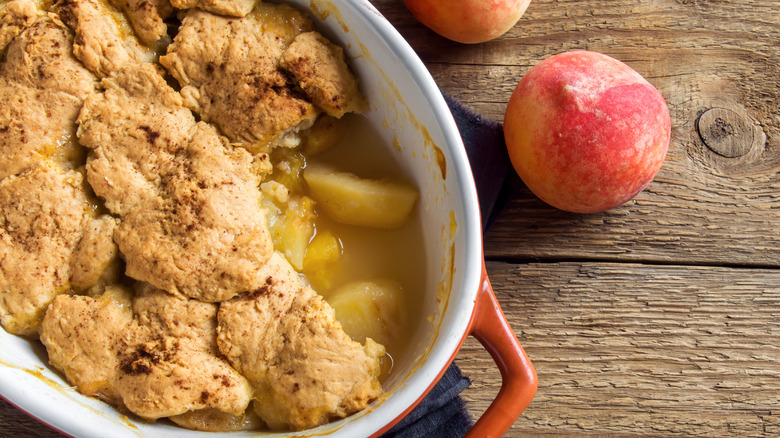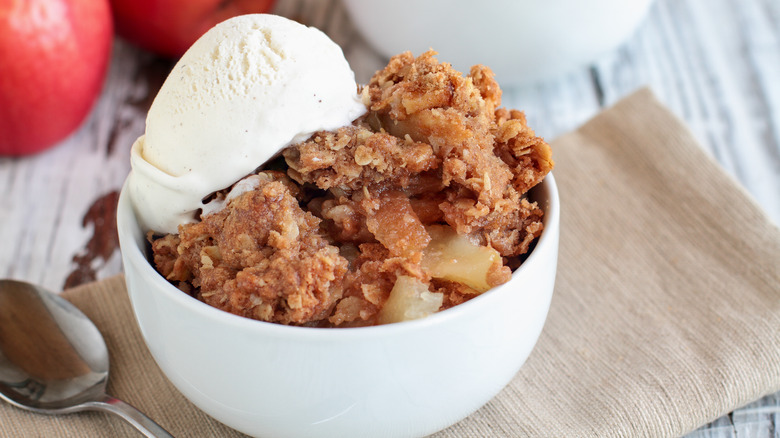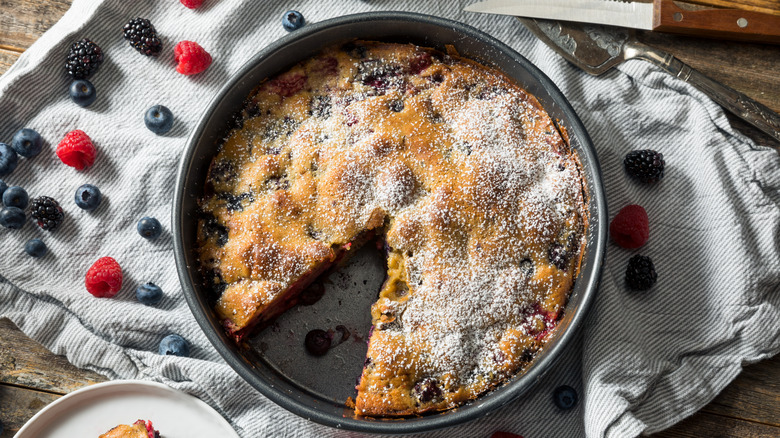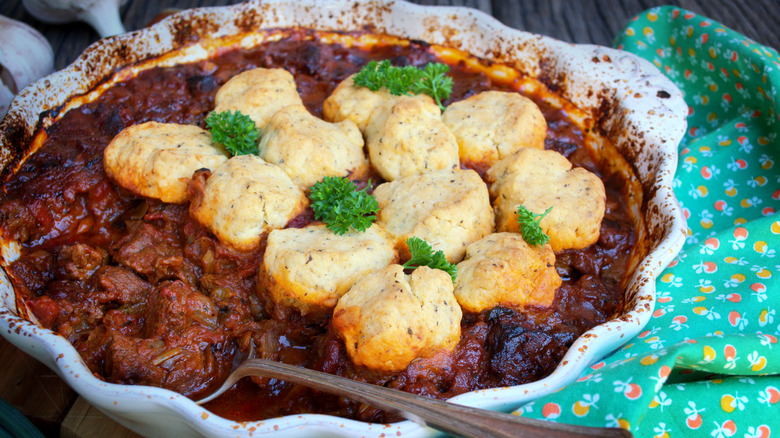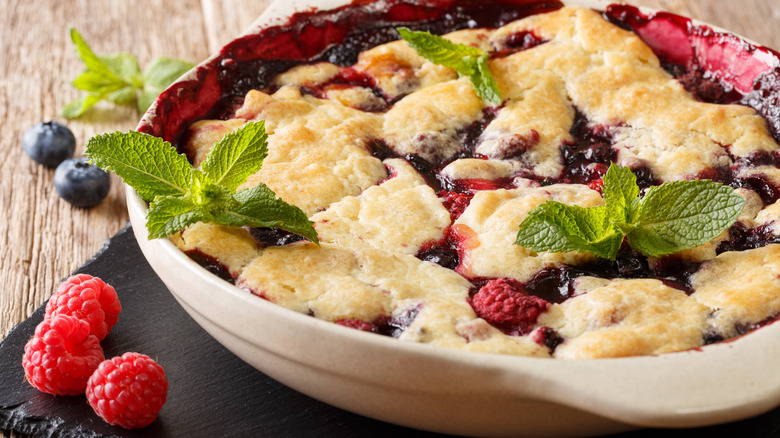The Biggest Mistakes Everyone Makes With Fruit Cobbler
One of the best parts about transitioning into a new season is the number of seasonal fruits we get to enjoy. Whether we're coming into fall and need to use up the last of our ripe summer peaches, plums, and blackberries, or in peak spring when we have ample amounts of rhubarb and strawberries. Sometimes we have to come up with ways to use the fresh fruits we have on hand.
A great way to utilize any ripe fruit — or use them up at the end of the season — is to bake it into a sweet and comforting dessert. And a cobbler is an ideal treat for this purpose. The origin of cobbler in the United States dates back to the American Colonial period and was likely created by adjusting European recipes to incorporate the easy-to-find local ingredients.
Traditionally, this dish is made with an in-season fruit filling and a sugary biscuit or pie-like topping. There are some regional differences within American cobbler recipes, and they are sometimes confused with crisps and crumbles or other topped desserts. But a cobbler is its own category of dessert, and it's lovely when prepared correctly. To make this delicious, fruit-filled treat, you'll want to be careful that you don't fall victim to these common mistakes everyone makes with fruit cobbler.
Using the wrong fruit
Fresh, ripe, and even almost overripe fruits work well in this syrupy dessert recipe. For the best results, stick to stone fruits, berries, apples or pears, and rhubarb. All of these options offer up a delicious flavor and tasty baked texture because they bake well and hold their shape while still getting tender enough to melt in your mouth. This creates a comforting perfect bite with the crispy crust.
Peach cobbler is one of the most popular, and fresh peaches are an excellent candidate for this confection. They're juicy, tender, and have just the right amount of sweetness without being too syrupy. A blackberry cobbler recipe is another favorite, and fresh berries work so well in these recipes because they are large enough to hold their shape and have a luscious, candied flavor when baked.
Don't assume you have to stick to fresh fruits. Frozen varieties are also a great staple when baking this biscuit-topped dish. When baking with frozen fruit, be sure to thaw it first and rinse it a few times to prevent color bleeding into your biscuit batter as it bakes. You may also want to pat it dry if thawing creates too much extra moisture. The only types of fruit you want to stay away from are canned, which can have a too-soft texture, and pre-made pie fillings, which will be overly sweet and sticky in this pastry-topped treat.
Confusing other fruit desserts
Cobbler is not the only baked fruit dessert we see on the table. It often gets confused for crisps or crumbles, which also have a syrupy base covered with a flavorful, hearty topping. But the differences lie in the preparation process and the ingredients of the topping. Don't mistake this biscuit-topped treat for any of these other fruit-filled fares.
The difference between a cobbler and a crisp is that the topping for a cobbler most resembles a sweet biscuit dough or batter that is scooped with a spoon and plopped onto the filling. This dessert's name actually comes from the cobbled texture on the top when the dough finishes baking. Crisps, on the other hand, are topped with a crumbly mixture of oats, flour, butter, and sugar that bakes up into a crispy, flaky topping.
What about crumbles? Yes, these are another fruity dessert on the scene and, according to New England Today, a crumble is similar to a crisp. But a crumble is topped with a mixture of flour, butter, and sugar — no oats. Just remember that a true cobbler is made with a dough or batter topping that is thick enough to be spooned and dropped atop the sweet filling. Other variations that require sprinkling, crumbling, or rolling the topping over the filling are not cobblers.
Creating a soggy crust
The topping is arguably the most important part of this fruity dish. The key to making this dessert stand out is having a gooey interior and a crispy, sweet exterior for a texture combination that melts in your mouth. Too often, the biscuit topping will mix with the syrupy filling and result in a doughy texture throughout the entire dish. To avoid this mishap, you can try hot water as an easy addition for crisp cobbler crust.
It may sound counterintuitive to add liquid to a recipe to promote crispness, but it works. Trust us. Just sprinkle some granulated sugar over your dough and or batter after assembling. Then, pour about a half cup of hot water over the top and let it and let it do its thing in the oven. It requires no different preparation process or cooking times and the results are well worth it. This hot water method is extremely easy and gives you a soft-centered, luscious dessert with a crispy brown topping that is perfect for pairing with a scoop of creamy vanilla ice cream.
Omitting cornstarch in the filling
Classic recipes call for cornstarch as a thickening ingredient in the filling. This addition helps turn the fruit's expelled juices into a lusciously thick sauce that soaks into the bottom of the topping, creating the perfect bite. A thickener is necessary when baking with fruit, as their water content is expelled during the baking process. Forgetting to add the starch will result in a soupy or watery base that lacks the silky mouthfeel you expect from this classic treat.
But why cornstarch? Why not use flour instead? According to Exploratorium's Science of Cooking, cornstarch begins to thicken when it reaches 203 degrees, and as it cools it begins to set. This creates a perfect consistency for the filling. Flour does not react in the same way, and you end up having to use much more of this thickener to achieve the same results. Flour also requires some cooking to remove its raw floury taste, and cornstarch doesn't have that issue. Lastly, cornstarch becomes clear as it warms, whereas flour stays white. So instead of a sauce that reflects the gorgeous color of the ingredients you chose, flour turns it into a cloudy, gray mess. We recommend that you always opt for cornstarch.
Not cooking at the correct temperature
Since this comforting dish should have a syrupy, sweet filling and crunchy biscuit topping, baking it properly is a must. Mistakes with baking can result in a dessert that has a soupy filling, or worse, a filling that burns to the bottom. And nobody likes to clean burnt sugar from the bottom of a pan. Improper cooking can also create a doughy, inedible crust, or a crust that is so dry even the saucy interior can't revive it.
The crucial step to perfecting this treat is to bake it at the right temperature. Since this dish is topped with a biscuit-like dough, you never want to bake cobbler at a very high temperature. Baking at too high a temperature — 375 degrees and above — increases the risk of overcooking or burning the top before the fruit cooks completely. The best cobbler recipes bake at 350 degrees, which allows the crust to cook slowly and gives the interior enough time to soften.
An easy way to tell if your fruit cobbler is done baking is to use a food thermometer. There is no more accurate way to tell if food is done cooking than by using an actual thermometer. Digital thermometers are extremely convenient for this purpose. The internal temperature should reach 200 degrees when it has finished baking. By accurately checking, you'll never have to worry about over- or under-baking this dessert again.
Using too much topping
While baking this gooey dessert at the proper temperature is a great way to ensure the tastiest results, there are also key steps in the preparation process to guarantee a delicious final product. When creating the topping, it will be a thick consistency, similar to biscuit dough or cake batter. This density can cause cooking issues, and this is the reason you don't want to put too much topping on fruit cobbler.
Overcrowding the crust or creating a layer more than 2 inches thick could cause the ingredients to steam rather than bake. This creates a wet filling and soggy crust that nobody wants to eat. The topping should be scooped and dropped onto the filling, leaving some space between dollops. This space is the key to allowing steam to escape so your dessert can bake properly. By also keeping the layer of crust under 2 inches in thickness, you're allowing the entire crust to bake to a crispy texture that pairs perfectly with the ooey-gooey base.
Haphazardly cutting the ingredients
A fundamental rule in cooking is to cut ingredients into uniform sizes. This ensures even heating and the perfect consistency throughout your dish. Rough chopping or haphazardly cutting ingredients can cause uneven cooking in certain areas, per Great Grub, which can lead to unpleasant bites that can ruin the entire meal. Though it takes more time and effort, the results of perfectly sized pieces are well worth it in the end. Fruit cobbler is no exception to this vital rule. No matter which ingredients you choose, always cut them as close to the same size as possible. Berry versions tend to be a little easier because the berries are mostly uniform to begin with. If you've got less time on your hands or get a little impatient with a knife, a berry recipe will be your best friend.
So what is the ideal size to cut peaches for a cobbler? What about other fruits? No more than half an inch thick. This size promotes even cooking and a soft, tender texture, which is exactly what you're looking for. Smaller slices end up mushy or mealy and will lose their shape completely. Stick to the half-inch rule and slice everything evenly for a foolproof filling that cooks perfectly every time.
Relying too heavily on the oven
Assuming the oven is your only option for baking this comforting dish is a common mistake. A traditional, cobbler-adjacent New England recipe called a slump is cooked on the stovetop (via PennState Extension). And there are easy and convenient slow-cooked varieties, too, like this slow cooker apple cobbler recipe.
To make this delicious snack in a slow cooker, you'll follow nearly the same process as creating it for the oven. Prepare fruit for the filling, mixing it directly in the slow cooker. Then, prepare a quick batter to drop on top. Store-bought batter works, too. You'll know this recipe is finished when the little dumplings of batter look dry and start to crisp along the edges. A food thermometer works great here as well to ensure it is the correct temperature throughout.
When preparing this treat on the stovetop, a skillet, cast iron skillet, saucepan, or dutch oven can be used. No matter which pan you choose, it must have a tight-fitting lid. The basic recipe calls to heat the filling on the stovetop, top with biscuit or dumpling batter, and then cover the pot to cook the biscuits. It's important not to overcrowd the biscuit dough if you're using this method. You need ample amounts of space to cook the dough thoroughly without steaming it.
Going overboard with sugar
While this treat is meant to be sweet, it is easy to be a little heavy-handed with sugar. This is a mistake you should try not to make. To avoid adding too much sugar to cobbler, experts suggest starting with half a cup and then adjusting based on the ingredients, as well as their ripeness. For ripe peaches, half a cup is plenty of sugar and will sweeten without overpowering the luscious peach flavor. For blackberries or raspberries, you may need to increase it to ¾ cup to balance the tartness. Fruits that aren't quite ripe yet may also need closer to ¾ cup. Adjust your recipe accordingly, but always remember that less is more when adding sugar to sweet fruit recipes.
Don't be afraid to add a little acidity to this delectable dessert, either. Too often, acid is overlooked in dessert recipes but it is just as crucial an ingredient as it is in savory dishes. Like salt, adding acid to a sweet dessert helps to balance the sweetness for a better overall taste (via Minor's Food Service). Adding a squeeze of fresh lemon juice to the base enhances the flavors and kicks it up to another level.
Sticking to sweets
We primarily talk about cobblers as sweet treats, but that isn't all this delectable recipe can do. In fact, savory varieties are just as tasty as their sugary counterparts. They require a little creativity with the ingredients, but these savory adaptations are a quick and flavorful dinner option that hits perfectly on a chilly night.
Instead of a syrupy interior, these savory versions have a stewed filling of meats or vegetables and then are topped with a traditional, and less sweet, biscuit or pastry topping. Tampa Bay Times reports that tomato cobbler is a savory twist on this dish that you will absolutely love, and we have to agree. Red and yellow cherry tomatoes are cooked with onions and garlic for a rich and comforting flavor. This recipe uses a cheese-filled biscuit dough on top of the stewed tomato base for an appetizing and ideal savory pairing.
Beef cobbler is another variation that's cozy and satisfying in all the best ways. You'll create a filling similar to a beef stew, with a thick and hearty consistency, and then top the stew with savory biscuits, like in this BBC recipe. Amp up the flavor in this type of recipe by using the best cuts of meat for beef stew and getting creative with herbs and other ingredients. Try using fresh thyme or rosemary, and even consider a cheese like sharp white cheddar or Gruyère in the biscuit dough for an even richer flavor.
Using a deep baking dish
The correct texture for this fare, whether sweet or savory, is a rich, thick filling under a crisp crust. Using the wrong baking dish can alter the texture, particularly of the filling. This results in a wet or soupy final product. The type of baking dish you use for cobbler will absolutely affect the outcome of your dish.
A deeper baking dish will retain more moisture, which can lead to a dessert that's too wet. Using a shallow baking dish is wise when working with fruit because of all the water content in the ingredients. Opt for a dish that is wide enough to hold all of your ingredients, but not so deep that you have a lot of extra space on top once you've filled the dish.
Depending on the ingredients you choose, it may also be wise to bake the filling and the topping separately. This can create the best composition throughout the entire dish. Preparing the filling on the stovetop and then topping it with a pre-baked crust or biscuit topping can result in a perfect texture pairing without worrying about a soggy crust or an underdone interior.
